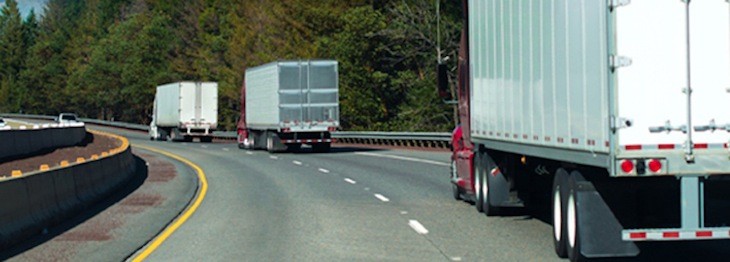2019: another good year for transportation
by February 5, 2019 4:59 pm 349 views

The transportation industry is expected to have another good year in 2019 subject to several factors, including trade-related concerns, said Doug Voss, associate professor of logistics and supply chain management at the University of Central Arkansas.
“I don’t think it’s going to be as historically good as 2018 was, due to the uncertainty that we’re seeing in trade, due to the uncertainty that we’re seeing in a number of other fronts,” Voss said. “There are some question marks there.”
The trucking industry would like to see Congress approve the new trade agreement between the United States, Mexico and Canada this year, said Voss, adding that trade relations with China remain a concern.
A top industry issue continues to be driver turnover and recruiting new drivers, but he said he doesn’t expect this to be solved in 2019. He also doesn’t expect the driver shortage to improve in 2019, barring a significant economic issue. Long-term, driver pay increases and changes to driver lifestyle and working conditions should help to lessen the shortage.
“Once you start seeing drivers paid on average $80,000 a year, there’s going to be less of an issue with trying to find drivers,” he said. “But that said, there are similar jobs out there, for instance, diesel mechanic or welders, who are paid somewhere around that level, and there are currently shortages in those fields too.”
Shannon Newton, president of the Arkansas Trucking Association, said the driver shortage has contributed to the health of the industry as a lack of drivers has constrained capacity, or the ability to deliver goods. But a long-term solution to the driver shortage is needed as the workforce ages and the number of people who join the industry is fewer than the number retiring. In Arkansas, the shortage is between 5,000 and 7,000 drivers, and it’s 50,000 nationwide.
“It’s going to be a long-term, slow burn, slow effort in order to attract those additional individuals to the industry,” Newton said. “There’s no silver bullet.”
Recently, the industry advocated an apprenticeship program to attract younger drivers and allow them to receive over-the-road training. Also, the industry has sought to provide flexibility in the hours-of-service rules, and the federal government has received comments on the proposed changes, including to allow drivers to split the time they spend in a sleeper berth instead of one long period. Another key industry issue will be transportation infrastructure funding, which is a nationwide and statewide concern. How it will be funded is uncertain, Voss said.
Expectations aren’t high for Congress to approve many issues with the mixed majorities of political parties in the House and Senate, but transportation infrastructure and workforce-related issues are non-partisan items that might be approved, Newton said.
“If the president chooses to engage and really take a leadership role in that, I think it’s possible,” she said. “Our industry is certainly going to be advocating for an infrastructure package early in 2019.”
Newton is more optimistic about the state legislature approving transportation infrastructure funding because of how long it’s been discussed.
“It’s not just industry talking about it anymore,” she said. “We now have individuals, constituents, average Arkansans. Their quality of life is being impacted by the lack of adequate infrastructure.”
Industry advocates, state lawmakers and Gov. Asa Hutchinson have discussed extending a half-cent sales tax for highways that expires in 2023. Some legislators and transportation leaders want to see additional efforts to secure money for roads and infrastructure, such as diverting road-related general revenues or raising gas taxes.
Newton also expects tort reform efforts to return as a proposed constitutional amendment, but she wasn’t ready to say what it might look like. A proposal to limit damages in certain lawsuits was kicked off the ballot by the Arkansas Supreme Court in late 2018 before voters could register their opinions on the issue.
Truck parking has become an increasing problem, especially after the electronic logging device (ELD) mandate went into effect in December 2017, Voss said. A push to address the issue has started at the state level, and it’s also being considered at the federal level.
“There’s less flexibility now for the drivers, and as a function, they have to stop when they have to stop,” he said. “But there’s no place to stop. There’s a shortage of truck parking.”
Spot market rates are one of the key metrics Voss follows to show how the industry is faring, and the rates have softened but not drastically. He expects rates to continue to moderate in 2019, but not significantly. He also follows the Cass Freight Index and the American Trucking Associations’ advanced seasonally adjusted For-Hire Truck Tonnage Index — both of which showed through November 2018 that the transportation industry continues to expand. Voss doesn’t believe capacity will be as tight in 2019 as it was in 2018; however, a shortage of good trucking capacity is likely to persist this year.
A push toward the electrification of vehicles is also expected to continue as range constraints of electric vehicles are addressed, Voss said. Vehicle automation technology is advancing, and within the next five to 10 years, self-driving vehicles should start to operate in controlled environments, such as at distribution centers or ports.
__________________
Editor’s note: This article first appeared in Talk Business & Politics State of the State 2019 magazine, which you can access here.
